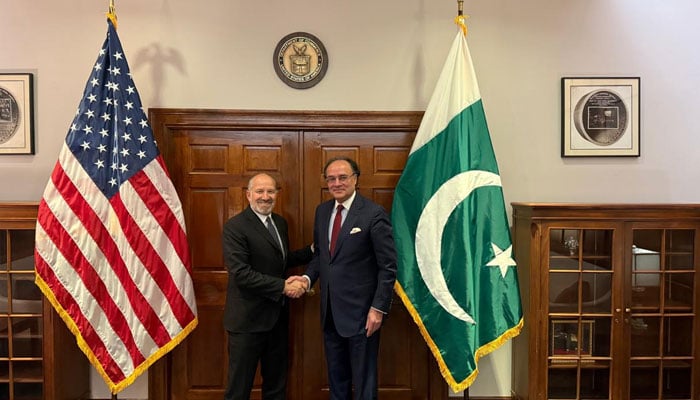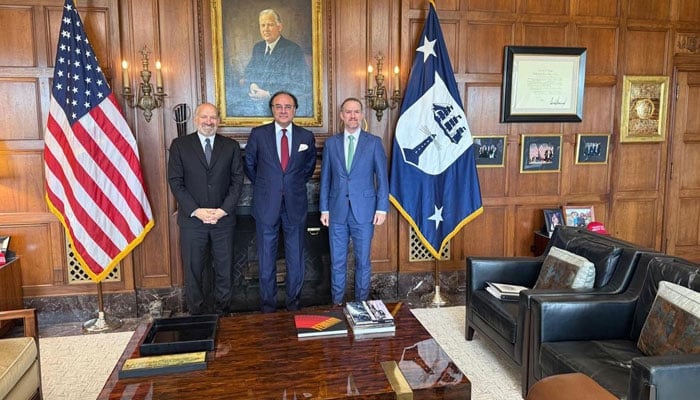FinMin Aurangzeb holds 'productive' trade, tariff talks in Washington
Finance czar terms US investment talks a game-changer
July 19, 2025

- Finance Minister meets top US trade and commerce officials.
- Islamabad pushes for preferential tariffs in Washington meetings.
- Pakistan may lower duties on US cotton and soybean exports.
ISLAMABAD: Finance Minister Muhammad Aurangzeb has held high-level talks with US officials as the country seeks tariff relief and stronger economic ties with Washington, The News reported on Saturday.
"Hopefully, trade talks will be concluded," said a top minister of the Shehbaz Sharif-led government when approached for comment on Friday night.
This scribe had sent a query to the finance minister last Wednesday regarding a possible visit to the US for tariff negotiations, but the minister did not respond.
However, he proceeded to Washington and met with US Secretary of Commerce Howard Lutnick and US Trade Representative Ambassador Jamieson Greer on Friday.
Following Chief of Army Staff Field Marshal Asim Munir’s recent visit to the US, both countries are finalising trade discussions. Sources indicate they are considering either a Preferential Trade Agreement (PTA) or a Bilateral Trade Treaty (BTT). Washington has been pursuing BTTs with countries with billions of annual trade deficits.

The US may grant Pakistan favourable textile tariffs (around 10%) in exchange for incentivised tariffs on American cotton and soybean exports to Pakistan. Both sides are exploring WTO-compliant incentives, official sources revealed.
Notably, the US has established 970 Research and Development (R&D) centres in India.
At this critical juncture, Pakistani negotiators must leverage this opportunity to secure maximum benefits. Past attempts, such as the Reconstruction Opportunity Zones (ROZs) negotiated during the Musharraf/ Shaukat Aziz era post-9/11, failed despite Pakistan's heavy sacrifices in lives and economic toll. Currently, Pakistan enjoys a trade surplus with the US, exporting $5.1 billion against imports of $2.1 billion—a $3.1 billion surplus.
While the US typically pursues BTTs with high-deficit partners, it is considering enhanced market access for Pakistan under existing frameworks. For instance, Pakistan's imports of US cotton and soybean could see tariff rationalisation under the newly enacted National Tariff Policy (2025-26 budget).
In return, the US may incentivise Pakistan’s textile sector by $2–3 billion annually. "Different options are under consideration, and both countries are finalising reciprocal tariff incentives," said official sources.
'Game-changer talks'
Finance Minister Aurangzeb has described ongoing trade talks with the United States as a "game changer" for Pakistan’s economic future, particularly in the areas of investment and technological development.
In a video statement following meetings in Washington with US officials, the minister said the discussions had been positive and forward-looking.
Aurangzeb highlighted that the United States is Pakistan’s largest trading partner and stressed the need to deepen this relationship beyond short-term trade gains. He called for a strategic shift in economic cooperation focused on long-term investments.
“We must move beyond immediate trade imperatives and bring the Pak-US relationship to the next level,” he said.
The minister noted that both sides have identified key sectors for future investment, including minerals, mining, artificial intelligence, digital infrastructure, and crypto technologies.
He added that expanding collaboration in these areas could significantly transform the economic ties between the two countries and unlock major development opportunities for Pakistan.
Earlier, a finance ministry statement confirmed that Aurangzeb’s delegation held a productive meeting with US officials, with both sides expressing satisfaction over progress in trade and economic ties.
Finance Minister Aurangzeb highlighted the US as Pakistan’s largest trading partner and stressed expanding cooperation in IT, minerals and agriculture. Both parties expressed optimism that ongoing talks would yield mutually beneficial outcomes.
A day earlier, Bloomberg reported that the finance czar was seeking discussions on several American demands laid out in a detailed list previously provided to a Pakistani delegation.
These demands include fulfilling preconditions for a trade deal, and reducing both tariff and non-tariff trade barriers.
Islamabad had initially expected to conclude the deal by early July, but the pace of talks has been slower than anticipated.
Pakistan also offered to increase imports of American cotton and soybeans, while emphasising that the US remains its largest export market. Notably, Pakistan is the second-largest buyer of US cotton in South Asia after China.











